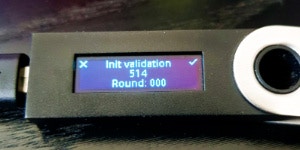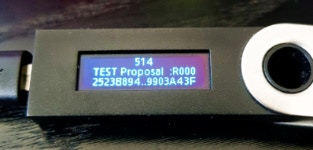KMS and Ledger Tendermint app are currently work in progress. Details may vary. Use with care under your own risk.
Tendermint Validator app (for Ledger devices)
You should be able to find the Tendermint app in Ledger Live.
Note: at the moment, you might need to enable developer mode in Ledger Live settings
KMS configuration
In this section, we will configure a KMS to use a Ledger device running the Tendermint Validator App.
Config file
You can find other configuration examples here
- Create a
~/.tmkms/tmkms.toml file with the following content (use an adequate chain_id)
[[validator]]
addr = "tcp://localhost:26658" # or "unix:///path/to/socket"
chain_id = "gaia-11001"
reconnect = true # true is the default
secret_key = "~/.tmkms/secret_connection.key"
[[providers.ledgertm]]
chain_ids = ["gaia-11001"]
- Edit
addr to point to your gaiad instance.
- Adjust
chain-id to match your .gaia/config/config.toml settings.
provider.ledgertm has no additional parameters at the moment, however, it is important that you keep that header to enable the feature.
Plug your Ledger device and open the Tendermint validator app.
Generate secret key
Now you need to generate secret_key:
tmkms keygen ~/.tmkms/secret_connection.key
Retrieve validator key
The last step is to retrieve the validator key that you will use in gaiad.
Start the KMS:
tmkms start -c ~/.tmkms/tmkms.toml
07:28:24 [INFO] tmkms 0.3.0 starting up...
07:28:24 [INFO] [keyring:ledgertm:ledgertm] added validator key cosmosvalconspub1zcjduepqy53m39prgp9dz3nz96kaav3el5e0th8ltwcf8cpavqdvpxgr5slsd6wz6f
07:28:24 [INFO] KMS node ID: 1BC12314E2E1C29015B66017A397F170C6ECDE4A
cosmosvalconspub1zcjduepqy53m39prgp9dz3nz96kaav3el5e0th8ltwcf8cpavqdvpxgr5slsd6wz6f
Take note of the validator pubkey that appears in your screen. We will use it in the next section.
Gaia configuration
You need to enable KMS access by editing .gaia/config/config.toml. In this file, modify priv_validator_laddr to create a listening address/port or a unix socket in gaiad.
For example:
...
# TCP or UNIX socket address for Tendermint to listen on for
# connections from an external PrivValidator process
priv_validator_laddr = "tcp://127.0.0.1:26658"
...
kmsval. You can tell gaiad the key that we’ve got in the previous section.
gaiad gentx --name kmsval --pubkey {.ValidatorKey}
gaiad. You should see that the KMS connects and receives a signature request.
Once the ledger receives the first message, it will ask for confirmation that the values are adequate.
 Click the right button if the height and round are correct.
After that, you will see that the KMS will start forwarding all signature requests to the ledger:
Click the right button if the height and round are correct.
After that, you will see that the KMS will start forwarding all signature requests to the ledger:

The word TEST in the second picture, second line appears because they were taken on a pre-release version.Once the app has been released in Ledger’s app store, this word should NOT appear.

